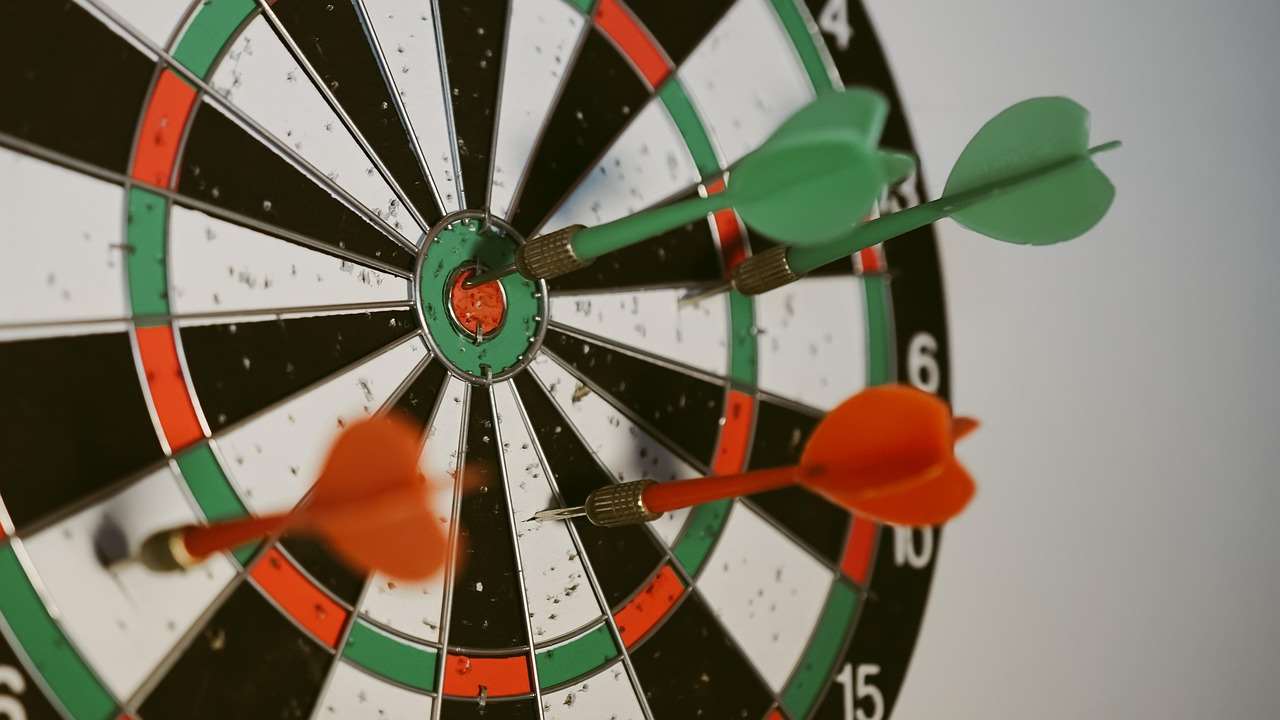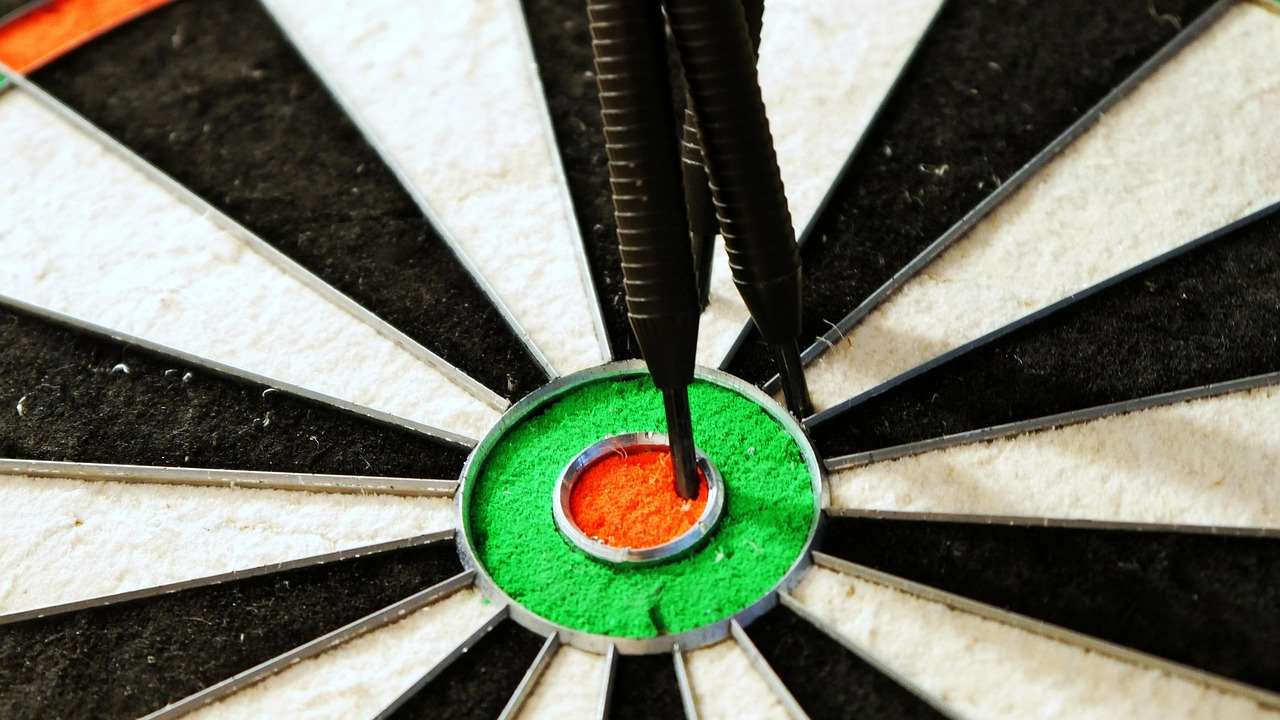The crucial difference when measuring oche carpet vs hard floor for dart games is accounting for the carpet’s compression underfoot, which impacts the throw line’s precise distance from the dartboard. This article breaks down the exact steps to ensure accurate measurements on both surfaces, covering essential considerations like carpet thickness, board height, and common measurement mistakes.
⚠️ Still Using Pen & Paper (or a Chalkboard)?! ⚠️
Step into the future! The Dart Counter App handles all the scoring, suggests checkouts, and tracks your stats automatically. It's easier than you think!
Try the Smart Dart Counter App FREE!Ready for an upgrade? Click above!
Understanding the Importance of Accurate Oche Measurement
Before diving into the specifics of measuring oche carpet vs hard floor, it’s essential to understand why accuracy matters. An incorrectly positioned oche (the throw line) can significantly impact your game. Too close, and you might feel cramped and unable to execute your throw properly. Too far, and you’ll find it harder to maintain consistent accuracy. Ultimately, a correctly measured oche ensures fair play and helps you develop your darting skills effectively. Ensuring accurate measurements can improve your experience and allow you to focus on Basic Darts Fundamentals for Beginners.
The Standard Oche Distance
The official oche distance, measured from the face of the dartboard to the front edge of the oche line, is 7 feet 9 1/4 inches (2.37 meters). This distance is crucial for sanctioned dart tournaments and provides a standardized playing field. It’s important to adhere to these measurements for competitive play, but you can modify them slightly for recreational games, especially when Adapting dart game rules for children.

Measuring Oche Distance on Hard Floors
Measuring the oche on a hard floor seems straightforward, but precision is key. Here’s a step-by-step guide:
- Prepare your tools: You’ll need a measuring tape (preferably a steel one for accuracy), a level, and a marker or tape to mark the oche line.
- Mount the dartboard: Ensure the center of the dartboard (the bullseye) is 5 feet 8 inches (1.73 meters) from the floor. Use a level to confirm it’s perfectly vertical.
- Measure from the board: Start your measurement from the face of the dartboard, not the wall behind it. Extend the measuring tape along the floor towards where the oche will be placed.
- Mark the oche line: At 7 feet 9 1/4 inches (2.37 meters), mark a clear line on the floor. This is where the front edge of your oche will be positioned.
- Install the oche: You can use tape, a wooden board, or a commercially available oche mat to create the physical throw line. Ensure the front edge aligns perfectly with your marked line.
Remember to double-check all measurements to avoid errors. Even a small discrepancy can affect your throw.
Addressing Challenges When Measuring Oche Carpet vs Hard Floor
The biggest challenge arises when dealing with carpet. The compression of the carpet underfoot effectively shortens the distance between the player and the dartboard. This difference needs to be accounted for to maintain the correct throwing distance. Consider the pile thickness of the carpet and how much it will compress under your weight. Failure to accurately factor in this compression will result in an incorrect distance and ultimately affect your game.
Compensating for Carpet Compression
Here’s how to compensate for carpet compression when measuring oche carpet vs hard floor:
- Determine Carpet Compression: This is the most crucial step. Stand on the carpet where you would normally throw. Have someone measure the difference in height between the uncompressed carpet and the carpet under your weight. Alternatively, you can place a flat board on the carpet and measure the compression under the board.
- Add Compression to Measurement: Add the compression measurement to the standard oche distance. For example, if the carpet compresses by 1/2 inch, the adjusted measurement would be 7 feet 9 3/4 inches (2.375 meters).
- Mark the Adjusted Oche Line: Use the adjusted measurement to mark the oche line on the carpet.
- Test and Fine-Tune: After setting up the oche, throw a few darts and assess how it feels. You may need to make slight adjustments based on your personal preference.

Choosing the Right Type of Oche
The type of oche you choose depends on your playing environment and personal preferences. Here are a few options:
- Adhesive Tape: A temporary and inexpensive option, suitable for occasional play. Use high-quality tape that won’t damage the floor.
- Oche Mat: A portable mat with a clearly marked throw line. Oche mats are a good choice for both carpet and hard floors, offering a consistent throwing surface.
- Wooden Oche: A more permanent solution, often mounted to the floor. Wooden oches provide a solid and stable throwing platform.
- Raised Oche: Some players prefer a raised oche, which is a platform that elevates the throw line slightly. This can help maintain balance and consistency.
Consider the pros and cons of each option before making a decision. A good oche should be durable, stable, and accurately positioned.
Common Mistakes to Avoid When Measuring
Even with careful planning, mistakes can happen. Here are some common errors to avoid when measuring oche carpet vs hard floor:
- Measuring from the Wall: Always measure from the face of the dartboard, not the wall behind it. The wall might not be perfectly vertical, leading to inaccurate measurements.
- Incorrect Dartboard Height: Ensure the bullseye is at the correct height (5 feet 8 inches). An incorrectly positioned dartboard will throw off the oche distance.
- Ignoring Carpet Compression: As mentioned earlier, failing to account for carpet compression is a common mistake.
- Using a Flexible Measuring Tape Incorrectly: Flexible measuring tapes can stretch or sag, leading to inaccuracies. Use a steel measuring tape whenever possible and keep it taut during measurement.
- Not Double-Checking: Always double-check your measurements before installing the oche.

Maintaining Oche Accuracy Over Time
Even after careful initial measurement, the oche can shift or become misaligned over time. Regular maintenance is essential to ensure continued accuracy. Here are some tips:
- Check the Oche Position Regularly: Use a measuring tape to verify the oche distance periodically.
- Inspect the Oche for Damage: Look for signs of wear and tear, such as cracks or loose edges.
- Clean the Oche and Surrounding Area: Dirt and debris can accumulate around the oche, affecting your footing and throwing stance.
- Replace the Oche When Necessary: If the oche is significantly damaged or worn, it’s best to replace it.
Taking these simple steps will help you maintain a consistent and accurate playing environment.
Advanced Tips for Oche Placement and Comfort
Beyond the basic measurements, there are a few advanced tips that can enhance your darting experience:
- Consider Lighting: Ensure adequate lighting around the oche. Poor lighting can strain your eyes and affect your accuracy.
- Provide Adequate Space: Ensure there’s enough space behind the oche for comfortable throw follow-through.
- Use a Dart Mat: A dart mat can protect your floor from stray darts and provide a consistent throwing surface.
- Experiment with Oche Height: Some players find that a slightly raised oche improves their balance and consistency.

The Psychological Impact of a Properly Measured Oche
The benefits of accurately measuring oche carpet vs hard floor extend beyond just physical precision. A properly measured oche contributes to a player’s confidence and mental game. Knowing that you’re throwing from the correct distance eliminates doubt and allows you to focus on your technique and strategy. This can lead to improved performance and a more enjoyable darting experience. Consider exploring Alternative darts rules for home play if you’re not adhering to the standard regulations.
Adapting Oche Measurements for Different Games and Players
While the standard oche distance is the norm for professional and serious amateur play, adjustments may be necessary for different games or players. For children or individuals with mobility limitations, shortening the oche distance can make the game more accessible and enjoyable. Similarly, in casual settings, you might experiment with different oche distances to add variety and challenge. Remember, the goal is to have fun and create a comfortable playing environment. However, if you want to learn How to make darts fairer with handicap rules, keep in mind that the oche distance should be consistent.

Final Thoughts on Achieving Oche Perfection
Accurate oche measurement is a fundamental aspect of playing darts, whether you’re competing in a tournament or enjoying a casual game with friends. Understanding the nuances of measuring oche carpet vs hard floor, accounting for carpet compression, and avoiding common mistakes will ensure a fair and enjoyable playing experience. Remember to prioritize accuracy, consistency, and comfort when setting up your oche. By following the steps outlined in this article, you’ll be well on your way to achieving oche perfection.
So grab your measuring tape, assess your flooring, and get ready to set up your dartboard with precision. Now that you know how to measure the oche, take the next step and improve your game!
Hi, I’m Dieter, and I created Dartcounter (Dartcounterapp.com). My motivation wasn’t being a darts expert – quite the opposite! When I first started playing, I loved the game but found keeping accurate scores and tracking stats difficult and distracting.
I figured I couldn’t be the only one struggling with this. So, I decided to build a solution: an easy-to-use application that everyone, no matter their experience level, could use to manage scoring effortlessly.
My goal for Dartcounter was simple: let the app handle the numbers – the scoring, the averages, the stats, even checkout suggestions – so players could focus purely on their throw and enjoying the game. It began as a way to solve my own beginner’s problem, and I’m thrilled it has grown into a helpful tool for the wider darts community.